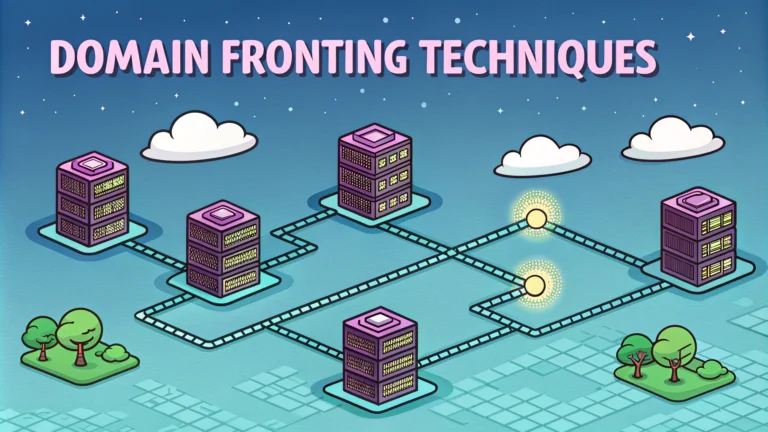Domain fronting enables bypassing internet censorship by hiding the true destination of network traffic behind seemingly innocent domains.
This technique leverages content delivery networks (CDNs) and other cloud services to mask connections to blocked services, making it appear as legitimate traffic to allowed domains.
While domain fronting has legitimate uses for privacy and avoiding censorship, it requires careful consideration of legal and ethical implications before implementation.
How Domain Fronting Works
- Uses different domain names between TLS and HTTP layers
- Outer TLS connection shows allowed domain (like google.com)
- Inner HTTP request connects to actual blocked service
- Traffic appears to come from legitimate CDN/cloud provider
Common Domain Fronting Services
| Provider | Status | Notes |
|---|---|---|
| Azure | Limited Support | Requires careful configuration |
| Amazon CloudFront | Restricted | Previously supported, now blocked |
| Google App Engine | Discontinued | No longer supports domain fronting |
Implementation Steps
- Select a supporting CDN provider
- Register domains and set up SSL certificates
- Configure DNS records appropriately
- Set up proxy server infrastructure
- Test connection masking effectiveness
Security Considerations
- Legal compliance: Check local regulations regarding traffic masking
- Provider policies: Review terms of service for CDN providers
- Traffic patterns: Monitor for suspicious activity patterns
- Data protection: Implement encryption for sensitive information
Detection Prevention
Implement random delays between requests to avoid predictable patterns.
Rotate between multiple front domains to prevent easy blocking.
Use legitimate-looking traffic patterns that match the fronted domain.
Alternative Techniques
- TLS tunneling
- Shadowsocks protocols
- Meek bridges
- Encrypted DNS
Tools and Resources
GAE-Proxy (Open source tool): https://github.com/gaeproxy/gaeproxy
Psiphon (Circumvention software): https://psiphon.ca
Tor Browser (Privacy-focused browser): https://www.torproject.org
Moving Forward with Domain Fronting
Domain fronting remains a useful technique for specific use cases despite increasing restrictions from major providers.
Success depends on staying current with provider policies and implementing robust security measures.
Consider combining domain fronting with other censorship circumvention methods for increased effectiveness.
Performance Optimization
- Minimize request latency through strategic server placement
- Implement connection pooling for resource efficiency
- Cache frequently accessed resources
- Use compression for data transfers
Monitoring and Maintenance
Key Metrics
- Connection success rates
- Response times
- Bandwidth usage patterns
- Error rates and types
Regular Tasks
- Certificate renewal
- Domain rotation
- Security patch updates
- Provider policy compliance checks
Common Challenges
- Provider detection and blockage
- Changing regulatory landscapes
- Performance bottlenecks
- Maintenance overhead
Future of Traffic Obfuscation
Emerging technologies and protocols continue to evolve as censorship methods become more sophisticated.
Machine learning and AI are increasingly being used for both detection and circumvention.
Decentralized approaches may offer more resilient solutions for traffic masking.
Best Practices for Sustainable Implementation
- Document all configurations and changes
- Maintain backup circumvention methods
- Build scalable infrastructure
- Establish clear usage policies
- Stay informed about technical developments
- Regularly assess security implications
FAQs
- What is domain fronting and how does it work?
Domain fronting is a technique that hides the true destination of web traffic by routing it through a trusted domain or CDN. It works by using different domain names at different layers of communication, typically using HTTPS to show one domain in the TLS layer while using another in the HTTP Host header. - Which major CDN providers were historically used for domain fronting?
Major CDN providers previously used for domain fronting included Amazon CloudFront, Google App Engine, and Akamai. However, many of these providers have since implemented measures to prevent domain fronting. - What are the common use cases for domain fronting in penetration testing?
Domain fronting in penetration testing is used to bypass network restrictions, evade detection, test egress filtering, validate security controls, and assess an organization’s ability to detect sophisticated command and control (C2) channels. - How does domain fronting differ from traditional proxy services?
Domain fronting operates at the application layer and appears as legitimate HTTPS traffic to high-reputation domains, while traditional proxies typically use dedicated IP addresses and protocols that are more easily identifiable and blockable. - What are the technical requirements for implementing domain fronting?
Implementation requires a CDN or service that allows SSL/TLS termination, the ability to manipulate HTTP Host headers, a registered domain, and proper SSL certificates. The front-end domain must be trusted and the back-end domain must be configured on the same CDN. - How can organizations detect domain fronting attempts?
Organizations can detect domain fronting by implementing TLS inspection, analyzing HTTP Host header discrepancies, monitoring for unusual traffic patterns to CDN providers, and using network security tools that can decode multiple layers of communication. - What are the limitations of domain fronting techniques?
Limitations include reduced availability of supporting CDN services, increased provider restrictions, potential performance overhead, complex setup requirements, and the need for continuous adaptation as providers implement new security measures. - What are the legal and ethical considerations when using domain fronting?
Domain fronting should only be used with explicit permission during authorized penetration testing. It may violate service providers’ terms of service, and unauthorized use can have legal consequences. Proper scope definition and documentation are essential. - How has domain fronting evolved in response to provider restrictions?
Domain fronting has evolved to use alternative services and techniques, including smaller CDN providers, multi-stage domain fronting, and new protocol-level approaches. Practitioners now focus on developing more sophisticated and resilient implementations. - What are some common alternatives to domain fronting?
Alternatives include protocol tunneling, DNS tunneling, Tor pluggable transports, domain rotation, and legitimate proxy services. These techniques may offer similar benefits while potentially being more acceptable to service providers.







